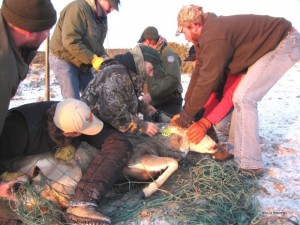Wyoming biologist studies deer migration, underpass use
LANDER — Biologist Tony Mong intends to find out how mule deer use a highway underpass north of Baggs.He also hopes to gain deer population estimates and survival rates from a recently started study relying on the animals' use of the underpass.
About 6,000 deer used the underpass during the fall and spring migrations of 2010 and 2011, according to a media release from the Wyoming Game and Fish said. The underpass was built in 2009 to help diminish wildlife and car collisions in the area.
Mong is a wildlife biologist for the department. He saw an additional benefit to the underpass — a way to easily monitor the area's deer population.In late December, Mong, along with local sportsmen, game wardens and Game and Fish biologists and Bureau of Land Management and U.S. Forest Service personnel, started a long-term project to monitor the animals.

He caught about 20 deer, a mix of does, fawns and mature bucks, luring them to a net with apple pulp, said Lucy Diggins-Wold, an information specialist with the department.Biologists then outfitted the deer with yellow ear tags that included identification numbers. They also took a blood sample from each animal. Mong hopes to eventually trap and tag about 100 deer a year.
Mong wants to see if the deer use the underpass multiple times during the year or just during migration. He also wants to see how many animals survive the winters. "That helps me make decisions on hunting seasons," he said.
Cameras, including a live video feed, in the underpass will help Mong visually track the deer. But he also hopes the public will call and report sightings of the tagged animals, which will give him a sense of where some travel.The animals will mainly be seen south of the Rawlins areas, Mong said.The deer tagged this year are just a start and won't be able to provide any conclusive data next year, Mong said.
"The more animals we have tagged, the better."
About 6,000 deer used the underpass during the fall and spring migrations of 2010 and 2011, according to a media release from the Wyoming Game and Fish said. The underpass was built in 2009 to help diminish wildlife and car collisions in the area.
Mong is a wildlife biologist for the department. He saw an additional benefit to the underpass — a way to easily monitor the area's deer population.In late December, Mong, along with local sportsmen, game wardens and Game and Fish biologists and Bureau of Land Management and U.S. Forest Service personnel, started a long-term project to monitor the animals.

He caught about 20 deer, a mix of does, fawns and mature bucks, luring them to a net with apple pulp, said Lucy Diggins-Wold, an information specialist with the department.Biologists then outfitted the deer with yellow ear tags that included identification numbers. They also took a blood sample from each animal. Mong hopes to eventually trap and tag about 100 deer a year.
Mong wants to see if the deer use the underpass multiple times during the year or just during migration. He also wants to see how many animals survive the winters. "That helps me make decisions on hunting seasons," he said.
Cameras, including a live video feed, in the underpass will help Mong visually track the deer. But he also hopes the public will call and report sightings of the tagged animals, which will give him a sense of where some travel.The animals will mainly be seen south of the Rawlins areas, Mong said.The deer tagged this year are just a start and won't be able to provide any conclusive data next year, Mong said.
"The more animals we have tagged, the better."











No comments:
Post a Comment